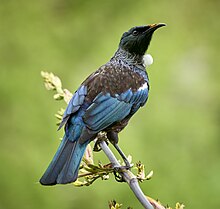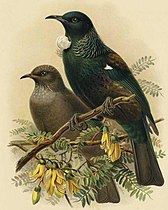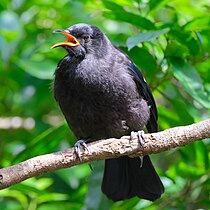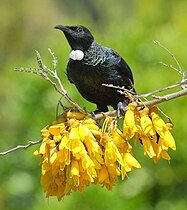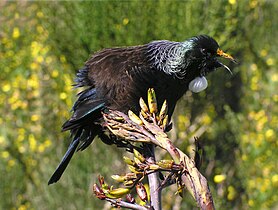
Kōwhai are small woody legume trees within the genus Sophora, in the family Fabaceae, that are native to New Zealand. There are eight species, with Sophora microphylla and S. tetraptera being the most recognised as large trees. Their natural habitat is beside streams and on the edges of forest, in lowland or mountain open areas. Kōwhai trees grow throughout the country and are a common feature in New Zealand gardens. Outside of New Zealand, kōwhai tend to be restricted to mild temperate maritime climates.

The New Zealand falcon is New Zealand's only falcon. Other common names for the bird are bush hawk and sparrow hawk. It is frequently mistaken for the larger and more common swamp harrier. It is the country's most threatened bird of prey, with only around 3000–5000 breeding pairs remaining.

The kererū or New Zealand pigeon is a species of pigeon native to New Zealand. Johann Friedrich Gmelin described the bird in 1789 as a large, conspicuous pigeon up to 50 cm (20 in) in length and 550–850 g (19–30 oz) in weight, with a white breast and iridescent green–blue plumage. Two subspecies have been recognised; the second—the Norfolk pigeon of Norfolk Island—became extinct in the early 20th century. Kererū pairs are monogamous, breeding over successive seasons and remaining together when not breeding. They construct nests with twigs in trees, with a single egg clutch.

The Pacific black duck is a dabbling duck found in much of Indonesia, New Guinea, Australia, New Zealand, and many islands in the southwestern Pacific, reaching to the Caroline Islands in the north and French Polynesia in the east. It is usually called the grey duck in New Zealand, where it is also known by its Maori name, pārera.
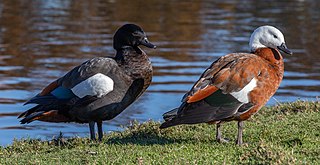
The paradise shelduck, also known as the paradise duck, or pūtangitangi in Māori, is a species of shelduck, a group of goose-like ducks, which is endemic to New Zealand. Johann Friedrich Gmelin placed it in the genus Anas with the ducks, geese, and swans. Both the male and female have striking plumages: the male has a black head and barred black body and the female has a white head with a chestnut body. They weigh between 1.09 and 2 kg and are between 63 and 71 cm in length.

The New Zealand scaup, also known as the black teal or pāpango in Māori, is a diving duck species of the genus Aythya endemic to New Zealand. They weigh around 650 grams (23 oz) and measure around 40 centimetres (16 in), and have dark-coloured plumage. They are found throughout New Zealand in deep natural and man-made lakes and ponds.

The New Zealand bellbird, also known by its Māori names korimako, makomako, and kōmako, is a passerine bird endemic to New Zealand. It has greenish colouration and is the only living member of the genus Anthornis. The bellbird forms a significant component of the famed New Zealand dawn chorus of bird song that was much noted by early European settlers. The explorer Captain Cook wrote of its song "it seemed to be like small bells most exquisitely tuned". The species is common across much of New Zealand and its offshore islands as well as the Auckland Islands.

Anthornis is a bird genus in the honeyeater family (Meliphagidae). Its members are called bellbirds. According to genetic data, it is a sister genus to Prosthemadera.

The stitchbird or hihi is a honeyeater-like bird endemic to the North Island and adjacent offshore islands of New Zealand. Its evolutionary relationships have long puzzled ornithologists, but it is now classed as the only member of its own family, the Notiomystidae. It is rare, being extirpated everywhere except Little Barrier Island, but has been reintroduced to two other island sanctuaries and four locations on the North Island mainland. Current population estimations for mature individuals in the wild are 2,500–3,400.

The red-crowned parakeet, also known as red-fronted parakeet and by its Māori name of kākāriki, is a small parrot from New Zealand. It is characterised by its bright green plumage and the red pattern on its head. This versatile bird can feed on a variety food items and can be found in many habitat types. It used to be classified as near threatened as invasive predators had pushed it out of its historical range but it is now at least concern. This species used to occupy the entire island, but is now confined to only a few areas on the mainland and some offshore islands.

The tomtit is a small passerine bird in the family Petroicidae, the Australasian robins. It is endemic to the islands of New Zealand, ranging across the main islands as well as several of the outlying islands. In the Māori language, the North Island tomtit is known as miromiro and the South Island tomtit is known as ngirungiru. This bird has several other Māori and English names as well. There are several subspecies showing considerable variation in plumage and size. The species is not threatened and has adapted to the changes made to New Zealand's biodiversity.

The shore plover, also known as the shore dotterel, is a small plover endemic to New Zealand. Once found all around the New Zealand coast, it is now restricted to a few offshore islands. It is one of the world's rarest shorebirds: the population is roughly 200.

The New Zealand pipit is a fairly small passerine bird of open country in New Zealand and outlying islands. It belongs to the pipit genus Anthus in the family Motacillidae.

The pipipi, also known as brown creeper, New Zealand creeper or New Zealand titmouse, is a small passerine bird endemic to the South Island of New Zealand. They are specialist insectivores, gleaning insects from branches and leaves. They have strong legs and toes for hanging upside down while feeding.

The Pacific long-tailed cuckoo, also known as the long-tailed cuckoo, long-tailed koel, sparrow hawk, home owl, screecher, screamer or koekoeā in Māori, is a species of the Cuculidae bird family. It is a migratory bird that spends spring and summer in New Zealand, its only breeding place, and spends winter in the Pacific islands. It is a brood parasite, laying its eggs in the nests of other bird species and leaving them to raise its chicks.

The spotless crake is a species of bird in the rail family, Rallidae. It is widely distributed species occurring from the Philippines, New Guinea and Australia, across the southern Pacific Ocean to the Marquesas Islands and south to New Zealand.

The Norfolk pigeon or Norfolk Island pigeon, sometimes called the wood quest, is an extinct subspecies of the New Zealand pigeon (kererū) that inhabited Norfolk Island. This population probably colonised Norfolk Island from New Zealand during the Pleistocene. It became extinct around the turn of the 20th century.
